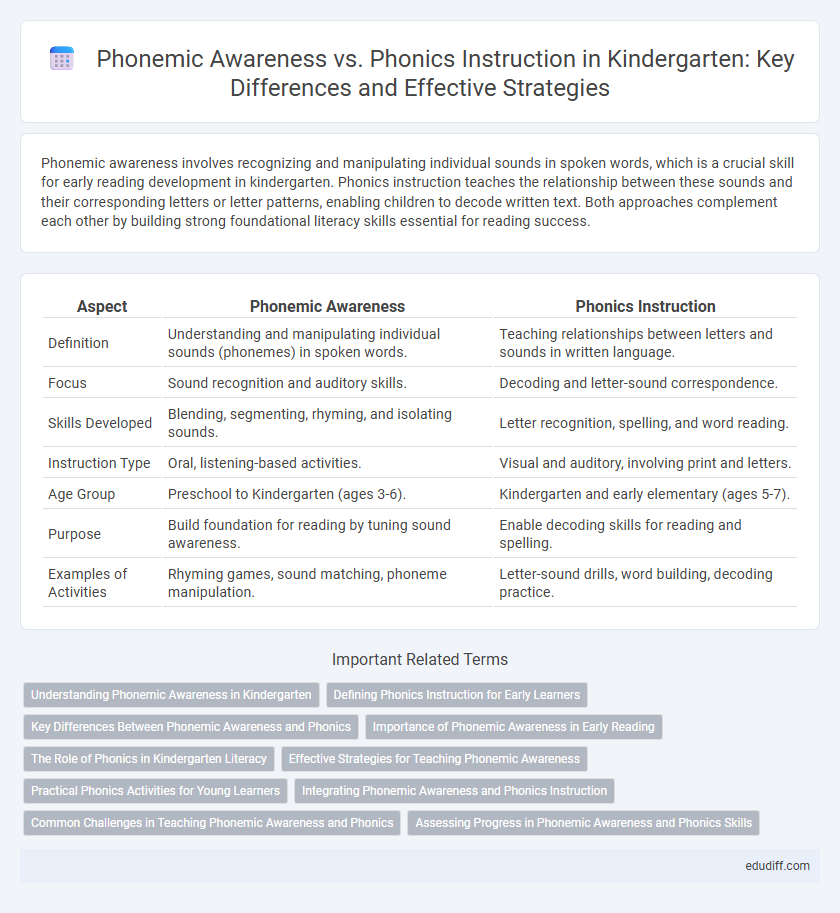Phonemic awareness involves recognizing and manipulating individual sounds in spoken words, which is a crucial skill for early reading development in kindergarten. Phonics instruction teaches the relationship between these sounds and their corresponding letters or letter patterns, enabling children to decode written text. Both approaches complement each other by building strong foundational literacy skills essential for reading success.
Table of Comparison
| Aspect | Phonemic Awareness | Phonics Instruction |
|---|---|---|
| Definition | Understanding and manipulating individual sounds (phonemes) in spoken words. | Teaching relationships between letters and sounds in written language. |
| Focus | Sound recognition and auditory skills. | Decoding and letter-sound correspondence. |
| Skills Developed | Blending, segmenting, rhyming, and isolating sounds. | Letter recognition, spelling, and word reading. |
| Instruction Type | Oral, listening-based activities. | Visual and auditory, involving print and letters. |
| Age Group | Preschool to Kindergarten (ages 3-6). | Kindergarten and early elementary (ages 5-7). |
| Purpose | Build foundation for reading by tuning sound awareness. | Enable decoding skills for reading and spelling. |
| Examples of Activities | Rhyming games, sound matching, phoneme manipulation. | Letter-sound drills, word building, decoding practice. |
Understanding Phonemic Awareness in Kindergarten
Phonemic awareness in kindergarten involves recognizing and manipulating individual sounds in spoken words, which is a crucial foundational skill for early literacy development. This auditory skill helps children segment, blend, and identify phonemes without relying on written text, preparing them for phonics instruction. Fostering strong phonemic awareness in kindergarten enhances decoding abilities and supports successful reading acquisition.
Defining Phonics Instruction for Early Learners
Phonics instruction for early learners involves systematically teaching the relationship between letters and sounds to build reading skills. This approach emphasizes decoding words by sounding out letter combinations, enabling children to recognize familiar patterns and improve word recognition. Effective phonics programs integrate visual, auditory, and kinesthetic activities to reinforce letter-sound correspondence and support literacy development.
Key Differences Between Phonemic Awareness and Phonics
Phonemic awareness involves the ability to hear, identify, and manipulate individual sounds--phonemes--in spoken words, while phonics instruction teaches the relationship between these sounds and their corresponding letters or letter patterns in written language. Key differences include phonemic awareness being purely auditory and oral without print, whereas phonics integrates visual recognition of letters and decoding skills. Effective kindergarten literacy programs emphasize phonemic awareness to build sound discrimination skills before introducing phonics for reading and spelling proficiency.
Importance of Phonemic Awareness in Early Reading
Phonemic awareness, the ability to recognize and manipulate individual sounds in spoken words, serves as the foundation for successful reading development in kindergarten. Research shows that children with strong phonemic awareness skills are more likely to excel in phonics instruction, which involves connecting sounds to letters. Emphasizing phonemic awareness during early reading sessions improves decoding skills, vocabulary acquisition, and overall literacy outcomes in young learners.
The Role of Phonics in Kindergarten Literacy
Phonics instruction in kindergarten plays a crucial role in developing early reading skills by teaching children the relationship between letters and sounds, enabling them to decode words accurately. While phonemic awareness focuses on the ability to identify and manipulate individual sounds in spoken language, phonics builds on this foundation by linking sounds to written symbols, facilitating word recognition and spelling. Effective phonics instruction supports kindergarten literacy by improving children's ability to read fluently and comprehend text, ultimately fostering a strong foundation for ongoing literacy development.
Effective Strategies for Teaching Phonemic Awareness
Effective strategies for teaching phonemic awareness include explicit instruction in identifying, segmenting, and blending sounds within words, which builds a strong foundation for reading skills. Incorporating multisensory activities such as sound matching games, rhyming exercises, and auditory discrimination tasks enhances children's ability to recognize phonemes. Consistent practice with these targeted techniques promotes decoding skills that are essential for successful phonics instruction.
Practical Phonics Activities for Young Learners
Phonemic awareness involves recognizing and manipulating individual sounds in spoken words, while phonics instruction teaches the relationship between sounds and their corresponding letters. Effective practical phonics activities for young learners include using letter-sound matching games, interactive alphabet charts, and phoneme segmentation exercises that build decoding skills. These activities enhance early reading proficiency by promoting sound recognition and blending in a hands-on, engaging way.
Integrating Phonemic Awareness and Phonics Instruction
Integrating phonemic awareness and phonics instruction enhances early literacy skills by connecting sound recognition with letter-sound correspondence, critical for kindergarten students. Effective instruction combines activities like segmenting and blending sounds with decoding practice using letter patterns, reinforcing the relationship between spoken and written language. Research shows that this integrated approach improves reading fluency, word recognition, and spelling accuracy in young learners.
Common Challenges in Teaching Phonemic Awareness and Phonics
Common challenges in teaching phonemic awareness include helping children distinctly recognize individual sounds within words, especially when differentiating similar phonemes or blending sounds fluidly. In phonics instruction, difficulties often arise in linking sounds to their corresponding letters or letter patterns, causing confusion in decoding words. Both require consistent practice to build automaticity and overcome obstacles such as limited vocabulary, speech sound disorders, and diverse learning paces.
Assessing Progress in Phonemic Awareness and Phonics Skills
Assessing progress in phonemic awareness involves evaluating a child's ability to recognize and manipulate individual sounds in spoken words through tasks like sound isolation, blending, and segmentation. Phonics assessment measures the child's ability to connect these sounds to corresponding letters and decode words accurately using skills such as letter-sound correspondence and word reading fluency. Continuous monitoring using standardized tools and formative assessments ensures targeted instruction and improvement in early reading development.
Phonemic awareness vs Phonics instruction Infographic

 edudiff.com
edudiff.com